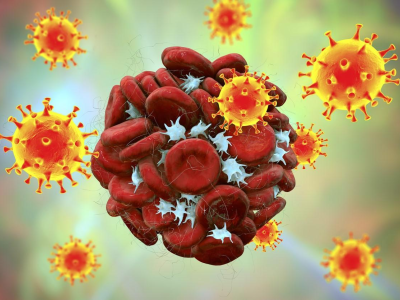Study suggests airline passenger spacing will slow COVID-19 spread
Keeping middle seats vacant on air flights has the potential to cut transmission of virus particles by 57% when multiple passengers are infected and by 23% when a single passenger is infected, according to an aerosol dispersion study that included earlier data that modeled plane airflow.
Researchers from the National Institute for Occupational Safety and Health (NIOSH) and Kansas State University reported the findings today in a Morbidity and Mortality Weekly Report (MMWR) study.
During the pandemic, a number of airlines blocked off the middle seats to assist with social distancing during flights, alongside mandatory masking. However, as demand for flights has increased, some have started booking middle seats again.
For the study, the researchers conducted aerosol dispersion experiments in plane cabin environments—a five-row section of a Boeing 737 and an 11-row section of a mockup. Ventilation systems used airline equipment, but without the jet engine. Mannequins emitting passenger-like heat were placed in the seats, and researched introduced bacteriophage MS2 virus, used before as a surrogate for pathogenic viruses, to simulate aerosol dispersion. The airflow modeling data were collected during a KSU study in 2017 as part of pandemic flu research, which didn't include mask use.
The authors said the 23% to 57% reductions they found for vacant middle seats, when compared with full seating, is similar the 45% reduction found in an earlier computational fluid dynamics simulation. The group pointed out that their study addressed only exposure and not transmission and only assessed aerosols, not fomites or droplets.
The researchers concluded that distancing by keeping middle seats vacant—along with current use of masks--could help reduce exposure, though the extent isn't fully understood. They also note that their study could help guide more studies of transmission risk, including those that look at mask use, virus characteristics, and host characteristics, such as vaccination.
Apr 14 MMWR report
Suicides stagnate or decline in wealthier countries during pandemic
Suicide rates largely remained stagnant or even declined during the early pandemic months in high- and upper-middle-income countries, according to a report yesterday in The Lancet Psychiatry.
The researchers first looked at real-time suicide data from 21 countries (11 of which had whole-country data with the rest composed of area-specific spots) from April to Jul 31, 2020, and compared rates with previous data from 1 to 4 years ago. Significant decreases in expected suicide rates were found in 12 areas (8 countries), ranging from New South Wales, Australia (rate ratio [RR] 0.81; 95% confidence interval [CI], 0.72 to 0.91), to Ecuador (RR 0.74; 95% CI, 0.67 to 0.82).
Some suicide rate increases were seen, though, and 10 of 35 areas had an RR greater than 1, peaking at 1.78 (Botucatu, Brazil). Further analysis of data through Oct 31, 2020, showed largely the same findings, with a few differences: Three areas showed significant decreases (Victoria, Australia [RR, 0.89]; Thames Valley, England [0.82]; Mexico City [0.86]) and three showed significant increases (Vienna, 1.31; Japan, 1.05; and Puerto Rico, 1.29).
"Governments and services need to remain vigilant for a possible delayed increase in suicides as a result of the pandemic. Suicide can be a lagging indicator of psychosocial difficulties, influenced by medium-term and longer-term disruptions to civic life and the economy," write Stella Botchway, BM BCh, MPH, and Seena Fazel, BSc, MBChB, MD, in a commentary. For example, they point out that Japan's suicide rates declined in the early months of the pandemic and then increased by at least 10%.
The researchers write that further study is needed to look at how suicide rates are stratified across age-group, sex, and race, as well as how public health mitigations and economic support may have affected mental health. Additionally, they note that low- or lower-middle-income countries may have different results.
Apr 13 Lancet Psychiatry study
Apr 13 Lancet Psychiatry commentary
Half of MIS-C patients have neurologic symptoms, unpublished data show
Twenty-four of 46 patients with multisystem inflammatory syndrome in children (MIS-C) displayed neurologic symptoms affecting the central and periphery systems, according to research being presented virtually at the American Academy of Neurology's (AAN's) 73rd annual meeting Apr 17 to 22. Previous data indicate that most cases of MIS-C have been associated after asymptomatic or mild COVID-19 infections.
The researchers looked at 46 children with MIS-C admitted to the Great Ormond Street Hospital in London from Apr 4 to Sep 1, 2020 (median age, 10.2 years). At presentation, half had headaches, 14 had encephalopathy, 6 had voice abnormalities or hoarseness, 6 had hallucinations, and 5 had ataxia. Additional testing showed that 14 of 15 who had an electroencephalogram had an excess of slow activity, and 4 of 7 who underwent nerve conduction studies and an electromyography had myopathic and neuropathic changes, according to the study's abstract.
Those who had neurologic symptoms were more likely to need a ventilator and circulation-related drugs, but there were no differences seen across demographics, inflammatory markers, management, or short-term outcomes. The researchers also noted that neurologic symptoms were seen more frequently in more severe presentations of MIS-C.
"Children who develop this condition should definitely be evaluated for neurologic symptoms and longer- term cognitive outcomes," said author Omar Abdel-Mannan, MD, in an AAN press release. "More studies are needed involving more children and following children to see how this condition changes over time and if there are any longer-term neurocognitive effects."
Apr 13 AAN abstract
Apr 13 AAN press release










